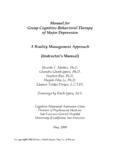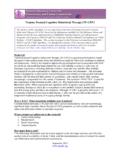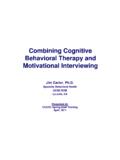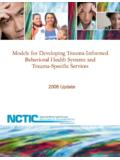Transcription of Cognitive Behavioral Therapy II - …
1 Cognitive Behavioral Therapy II By: John Porter Northwest Frontier Addiction Technology Transfer Center May, 2011 Pre-Contemplation / Contemplation Sessions 1 1 Session I STAGES OF CHANGE Purpose of the group: To provide information to participants about Stages of Change. To help participants understand how behaviors change. Goals for this group: Participants will understand Stages of Change Participants will be able to identify Stages from scenarios Participants will be able to identify their current Stage of Change What you need to conduct this group: Handouts: Stages of Change What is my current Stage of Change? A good understanding of Stages of Change Read p.
2 39 46 in Velasquez Group Treatment for Substance Abuse The Process: You will likely have participants who are in a pre-contemplation/contemplation Stage. Participants in stage may be in the group as a result of behaviors that have involved them in the criminal justice system or under duress to attend treatment. These participants may be resistant to treatment so it is important to engage them as much as possible and make them feel welcome in the group. Be prepared to use your best MI skills. It s very important to avoid resisting the resistance . Participants who feel forced into treatment may test you and attempt to set you off or otherwise create havoc in a group. It s important to engage, meet them where they are and help them feel comfortable in group by inviting them to participate, asking permission at every step and complementing and thanking them whenever possible.
3 It is important to create an environment in group that is inviting and safe. There should be no confrontation, put downs or interrogation from anyone. STEP ONE: Start this first group by establishing group rules. Have an easel and flipchart to record the rules the group agrees to abide by to help create a feeling of safety and cohesion. Record the rules and then post those for future reference as needed. When a participant violates a rule, gently remind everyone of the rules and ask if participants will be willing to abide by the rules. Some suggestions for rules: 1. Respect oneself and others in the group 2. Avoid interrupting when others are talking 3. Avoid cross-talk and private conversations 4. Avoid name calling or put downs of any kind 5. Provide feedback in a respectful manner 6. Accept feedback without becoming defensive 7.
4 Ask permission for content to be confidential 8. Cell phones should be off 9. No eating, drinking or chewing 10. Assist group members in creating any additional rules to provide for safety 2 Stages of Change Group Page Two STEP TWO: Introduce the Group to Stages of Change by providing handouts and explaining the Stages. Precontemplation This stage is one in which the individual is unaware or unwilling to consider that a problem exists. This typically means that the individual sees no need for change in his/her life. Contemplation The individual in contemplation is often considering that there may be a problem or concern in his/her life. They are considering the need for a change in their lives but are not yet ready to take any action. They may be evaluating options or searching for answers.
5 They often want to know how other people do it . Preparation In preparation, the individual has acknowledged that problems exist and is ready to make a commitment to changing. This individual has a plan in mind and may need support and direction to get started. Action Individuals in the action stage are actively engaged in making changes in their lives. They have a plan; they are executing a strategy to make change permanent. Maintenance Persons in this stage have made changes in their lives and are now integrating the changes in his/her lives so those changes feel normal. This individual usually feels secure with the change but continues to need support and encouragement. It is important to explain that ambivalence is normal. People move from one stage to another constantly depending on the day, the mood and the situation.
6 It is very easy to revisit a stage or recycle through the stages several times before successfully making permanent change in one s life. Discuss the concept of ambivalence and how normal individuals change their mind about many things on a day to day basis before having an absolute opinion about something. Ask how individuals come to a conclusion about how they feel about something. Examples: Do I want a hamburger or a salad for lunch today? Do I want to go see a movie tonight or have a quiet night at home? Ask participants what it takes for them to make up their mind about anything in which they experience ambivalence or an inability to make a decision. Allow discussion. Explain that often it is a matter of obtaining information. When an individual believes he/she has the necessary information to come to a conclusion about an issue, at that time and at that time only, individuals make up their minds.
7 STEP THREE: Read the scenarios that illustrate the various Stages of Change. Ask participants to refer to the characteristics of each stage to identify which stage is represented in each of the scenarios. You may want to have copies of the scenarios available for participants as you read to them. Help them come to a correct conclusion by providing hints as needed. 3 Stages of Change Group Page Three STEP FOUR: Provide the handout Where am I? ( Velasquez, page 46 ) Ask participants if they are willing to select the Stage of Change that represents their position at this time. Allow for discussion and acknowledge that is it ok to be at any Stage. There is NO right answer and no pressure for any participant to be at any particular stage. STEP FIVE: Close the group by asking the group to provide feedback regarding the value of this group.
8 Ask them to be specific and indicate what they learned as a result of being in the group. Remind the group of the next meeting date for this group. Thank them for their attendance and participation. Since this is a first group, it is a good idea to allow additional time for any questions aor clarification. 4 Stages of Change Scenarios Randall has been thinking about going on a diet. He recently got word from his doctor that his glucose level is elevated and his blood pressure is at a level that requires medication. He quit eating breakfast for a couple of weeks but has now returned to his standard breakfast of eggs, bacon and toast with orange juice and a bagel. He asked one of his friends how he had lost weight and even joined a gym. When his friend called to work out with Randall at the gym, Randall made an excuse rather than go work out with his friend.
9 Randall wants to loose weight and get his blood glucose and blood pressure under control. He thinks he will make it his New Year s resolution and get serious about the diet and work out plan in about six week. ( precontemplation ) Patsy used cocaine for about 10 years before she entered treatment and successfully completed a residential program. Since finishing her treatment Patsy has been involved in a community sponsored recovery group which she attends every week at least once. She remembers the difficulty she experienced in her life and her family during those years she was addicted. She is happy to have her anger under control and no longer hang out with friends who only goals in life are to find the day s supply. Patsy says she feels so much better about herself and the new job she has now held for the past two years.
10 ( maintenance ) Edward wants to quit smoking so he recently attended a meeting at a community based treatment center focused on smoking cessation. He is determined to kick his habit so he had visited his physician and obtained a prescription for the nicotine patches. He feels very anxious about trying to quit without support. Many of his friends and co-workers are smokers. He has cut down to half pack a day and wants to find a support group that he can attend in the evenings when he usually smokes the most. Edward is convinced that smoking is making him feel weak and lacking in energy. ( contemplation ) Jason has quit drinking after his second DUI. He learned about the disease of alcoholism in the DUI classes he was required to attend. Jason started attending a local meeting of Alcoholics Anonymous and is going on a regular basis.




